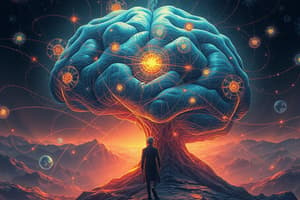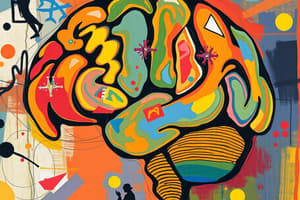Podcast
Questions and Answers
What is one of the key differences between short term memory (STM) and long term memory (LTM)?
What is one of the key differences between short term memory (STM) and long term memory (LTM)?
- STM has unlimited capacity while LTM is limited.
- STM decays quickly unless rehearsed, while LTM mainly forgets due to interference. (correct)
- LTM does not require any rehearsal to retain information.
- LTM is primarily phonological while STM is semantic.
Which of the following accurately describes the duration of sensory memory?
Which of the following accurately describes the duration of sensory memory?
- Iconic memory lasts approximately 2 seconds.
- Both iconic and echoic memories last indefinitely.
- Echoic memory is shorter than iconic memory.
- Iconic memory duration ranges from 80 to 200 ms. (correct)
What does the term 'chunk' refer to in the context of memory?
What does the term 'chunk' refer to in the context of memory?
- A strategy to combine unrelated items into groups.
- A single unit of information that can be stored in STM. (correct)
- An innate ability to recall long sequences of information.
- A method to erase information from memory.
What is the capacity of short term memory (STM) often described as?
What is the capacity of short term memory (STM) often described as?
Which component of Baddeley's model of working memory is primarily responsible for processing auditory information?
Which component of Baddeley's model of working memory is primarily responsible for processing auditory information?
What is the nature of forgetting in long term memory?
What is the nature of forgetting in long term memory?
What aspect of working memory does the central executive control?
What aspect of working memory does the central executive control?
What type of memories are known as flashbulb memories?
What type of memories are known as flashbulb memories?
Flashcards are hidden until you start studying
Study Notes
Short-Term Memory (STM) and Long-Term Memory (LTM)
- STM has limited capacity, while LTM is considered to be unlimited; STM acts as the "only place we exist" while LTM is significantly more vast.
- STM decays within 20 seconds without rehearsal, while LTM forgetting is due to interference rather than decay.
- STM codes information phonologically, while LTM uses a semantic code.
- Clive Wearing, a man who only has STM, illustrates the significance of LTM, demonstrating "a moment-to-moment consciousness."
Modern Approach to STM: Working Memory
- Working memory replaces the traditional view of STM, encompassing a central executive, an episodic buffer, and "slave" systems like the phonological loop and visuo-spatial scratch pad.
- The phonological loop processes auditory information and is impacted by the speed of speech, illustrating how language can influence memory.
Types of Memory
- Sensory memory acts as a short-term buffer, encompassing iconic (visual) and echoic (auditory) memory.
- Iconic memory has a duration of 80-200 milliseconds, while echoic memory lasts for 2 seconds, potentially due to the complexity of auditory information, particularly language.
- Short-term memory primarily stores information in a sound-based format, as evidenced by serial position effects.
- Primacy effects (remembering the beginning of a list) are transferred to LTM, while recency effects (remembering the end of a list) are dumped.
Working Memory
- A "chunk" is a group of familiar stimuli stored as a single unit within STM.
- Working memory allows for a perceived expansion of STM's capacity, as individuals only need to recall 4 ± 1 chunks.
- Baddeley's Model of Working Memory (2001) proposes four components: the phonological loop, central executive, visuospatial sketchpad, and episodic buffer.
- Working memory capacity (WMC) refers to the ability to hold and manipulate information within conscious attention.
Long-Term Memory (LTM)
- LTM is a vast storage system with an unlimited capacity, capable of retaining information over long periods.
- Flashbulb memories refer to vivid and detailed recollections of momentous events, often with a strong emotional connection.
Studying That Suits You
Use AI to generate personalized quizzes and flashcards to suit your learning preferences.




